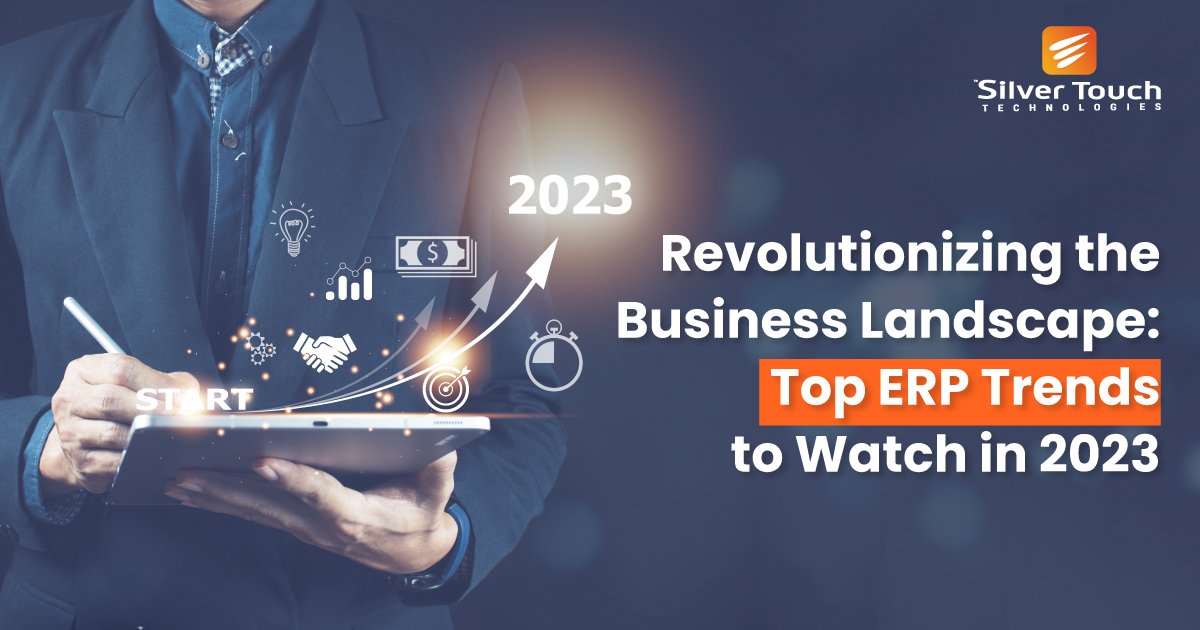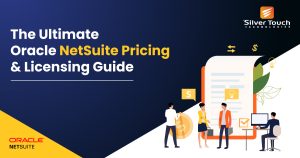The special thing about ERP is that it is a dynamically changing software. ERP software changes based on evolving business needs. So every year, you can expect ERP systems to include new features and functionalities. ERP companies add features based on the prevailing trend. In 2023 as well, there are some specific trends that shape the decision of ERP makers to add new functionalities.
The ‘Why’ of ERP: Reasons Behind a Company’s Decision To Implement ERP
Before getting into the 2023 ERP software trends, let’s give you a brief refresher on why companies give so much importance to ERP. Why is it that companies using ERP, too, closely track which new functionalities are being added to the system? That’s because there is a close relationship between their operational efficiency and how efficient their ERP is. If a company uses an ERP that – for example – can’t connect its marketing department with the sales and inventory departments, then there might be a disparity between the customer data that it has and customer data available with the sales department.
In summary, an ERP automates the flow of information. Since the efficiency of the operational process depends largely on this flow of information, an ERP directly impacts a company’s success (or failure). Modern ERPs go beyond the task of automating information flow. Today ERPs are equipped with AI-based analytics. They analyse business data and come up with actionable insights helping the company stay ahead of the curve.
ERP Software Trends For 2023 and 2024
ERP companies take evolving business needs into account while adding new features to their ERPs. Hence ERP software trends closely follow the general technological trends in the business world. Here are 9 trends that are shaping the world of ERP in 2023 and beyond
1. Sustained Importance on Cloud ERP
Like in previous years, businesses are continuously moving their on-prem ERP to the cloud. And among these businesses, the ones that are in favour of opting for SaaS-based ERP are in greater numbers. Cloud-based ERP offers a lot of benefits that translate to not just cost-saving but time-saving as well. Cloud-based ERPs – especially SaaS ERPs – remove the requirement for buying expensive physical hardware. So, companies don’t need to spend a lot of money upfront. This, in turn, results in further cost-saving for companies as they don’t need to hire expensive IT specialists to manage the ERP – everything is managed either by the ERP company or the vendor. Lastly, cloud ERP solves the issue of spending too much time on ‘figuring out’ whenever the system fails to function optimally.
Estimates by Statista show that the global Cloud ERP revenue is projected to grow at a CAGR of 13% – from 14.7 billion USD in 2018 to 40.5 billion USD in 2025. This figure poignantly shows the growing popularity of cloud ERP.
2. Integration of IoT and Big Data Analytics Capabilities Into ERP
The role of ERP has graduated from being just a “single source of truth” to a full-on IoT system that has the power to crunch big data. For example, the flagship ERP for small businesses – SAP Business One – can be used as an IoT device to control the production order. This means no one needs to be present in the factory to commence production manually upon receiving the production order.
Today companies generate huge amounts of enterprise data. It would be cumbersome to export that to an external data analytics system like Tableau to get insights. What source of the data – the ERP – itself had the ability to analyse big data? Wouldn’t that make the analytics process simpler? Today, almost all renowned ERPs do have analytics power built into the system. In fact, SAP has taken its data analytics prowess to another level with its in-memory database, HANA, which significantly speeds up the data processing time. The trend of integrating IoT capabilities with ERP will continue in 2023.
3. Real-time Data Analytics
No IoT system can work properly if it does not have real-time data processing capability. As more and more ERPs are aiming to provide IoT capabilities, they have no choice but to integrate real-time data analytics capabilities. Even for non-IoT-related tasks, ERPs like SAP S/4 Hana offer solutions like embedded analytics that provide real-time analysis of incoming data.
4. ERP Mobility
It’s the world of smartphones and remote work. Gone are the days when you have to be within the company premises, sitting on a specific computer to access the ERP system. In 2023, if employees can’t access relevant data (data that they have permission to view) available in the ERP system, then the whole purpose of ERP will be defeated.
Consider this. Your company has assigned a salesman to visit 5 of your customers who haven’t bought from your company for more than 3 months. Wouldn’t it be cumbersome to create a printout of the transactions and examine which customers haven’t bought from you during the past three months? This is where the SAP Business One smartphone app comes in. In the app, the salesmen can find the ‘Recency’ – the number of days after a certain customer placed their last sales order. Thus, the salesmen can get information about such customers on the go – no need to visit the office to get the data.
5. AI & Machine Learning Capabilities
Another trend that’s gaining momentum is the integration of Machine Learning capabilities into the ERP system and making the whole system intelligent. For example, in SAP S/4 Hana, the system examines all the sales enquiries and examines which one among them has the biggest potential to be converted to an actual sales order. SAP has its own Conversational AI chatbot that can be integrated with S/4 Hana, which makes managing business processes simpler with the use of voice commands. These are just two use cases. Modern ERPs are integrating AI-based functionalities in a big way. Now that the whole world is influenced by the emergence of GPT-3, GPT-4 and so on, it is but natural for ERP software to adopt such powerful AI capabilities.
6. More Focus On Content Marketing
In this competitive world, automating the business process won’t be enough. You need to automate your marketing strategy as well. And by ‘marketing’, we are talking about modern marketing paradigms like digital marketing and content marketing. Modern ERPs provide robust platforms to enable businesses to create and execute automated marketing tasks from the ERP screen itself. SAP Business One has a built-in campaign manager that can be used to create and execute email campaigns, phone campaigns and more.
SAP is also on the path of upgrading its standalone marketing solution – SAP Marketing Cloud. SAP aims to address the limitations of Marketing Cloud now that it has acquired Emarsys. Emarsys is a leading Digital Marketing solutions provider with a special focus on personalised customer experience. This move shows how important it is for SAP to provide a robust Digital Marketing experience.
7. Customised ERP Solution
Each and every business is unique. Two businesses in the same industry can have pain points that are different from one another. This is why, when it comes to ERP, one size does not fit all. This is where the role of ERP vendors like Silver Touch Technologies comes in. While ERPs provide a predictable suite of services, it is the vendors who customise the ERPs based on the requirements of their clients. And this customisation is necessary for businesses to be able to get value out of their ERP system. This trend of providing customised solutions has got stronger in 2023.
8. ERP For 3D Printing
One interesting trend that can be seen continuing in 2023 is the trend of ERP being used in additive manufacturing or 3D printing. While there is already more than enough ERP software for the manufacturing industry, 3D requires specialised manufacturing ERP that can work in collaboration with CAD software. The term 3D printing might sound too esoteric; it includes all the basic manufacturing processes that traditional manufacturing has. You need to specify which raw materials will be used, the number of raw materials to be used, what process to be followed and so on.
Hence, the aspect of planning, monitoring and logging the output remains the same. This is exactly where the role of ERP in 3D printing comes in. Planning, monitoring, remaining compliant with guidelines- everything can’t be handled by the CAD software. The CAD software needs its ERP friend. 3D printing is still in a nascent stage, but it is expected to grow at a CAGR of more than 23%. This is why forward-thinking ERP companies are coming up with functionalities to support the additive manufacturing process.
Future of ERP Software
ERP software powers the internal processes of a company. No growth-focused company can visualise its internal processes without bringing ERP into the equation. This is why the demand for Enterprise Resource Planning will always be there.
Statista estimates that in the UK alone, the revenue of the ERP software industry will grow at a CAGR of 6.51% from 2023 to 2028.
Since there is a cost-cutting trend prevalent in 2023, ERPs that can do the work of Business Intelligence software as well will be in great demand as companies would like to avoid spending more money to buy BI software.
However, companies should also start upgrading their legacy ERP installation as ERP companies are slowly pushing for cloud ERP. A company that needs full control of its ERP can opt for cloud ERP that is hosted in its own AWS, Azure or GCP platform. If a company needs to offload this technological complexity, it can opt for a managed ERP platform or SaaS-based ERP. The future of ERP is marked by flexible implementation.
2023 Is The Year When Startups Are Feeling The Heat of an Economic Downturn
Due to various geopolitical, economic and environmental issues, startups are afraid of an impending recession. VC money is getting dried up. In this scenario, it becomes difficult for small businesses and startups to buy expensive ERP software.
Hence in 2023, we are seeing the trend of companies searching for cheap ERP solutions as, unfortunately, they are unable to buy the high-end ones. Fortunately, renowned ERP companies like SAP have not ignored the pains of small businesses. SAP Business One, for example, is an ERP that SAP offers specifically to small businesses. It has everything in it that a small business or startup needs in an ERP. This trend of companies looking for affordable-yet-good ERP will continue for a while.
Trends Are Okay. What About Stability?
It is great to see renowned ERP companies following the trends and implementing cutting-edge functionalities in their ERP software. However, at the end of the day, companies need stability and predictability. This is why ERPs like SAP S/4 Hana or SAP Business One are still market leaders. These ERPs come up with newer technologies without disrupting their inherent predictability.
At the end of the day, the market will favour the ERP company that can continue providing proven solutions to issues businesses face and, at the same time, come up with newer functionalities. If you want such an ERP that can balance stability and cutting-edge functionalities – you are in the right place. Contact Silver Touch Technologies to build a stable and future-proof business process.
FAQs About ERP Software Ttrends
The future trends of ERP include cloud-based systems, AI and automation, and mobile ERP. Additionally, blockchain, IoT integration, and customization/personalization are expected to shape the industry. Overall, ERP vendors will continue to adapt to changing market demands and customer needs, driving innovation and flexibility.
ERP software is a type of software that helps businesses manage and automate their core processes, such as finance, human resources, and supply chain management. It integrates these functions into a single database, providing real-time data sharing and better decision-making.
The current trend in ERP systems is the adoption of cloud-based solutions, which offer greater flexibility, scalability, and accessibility. Cloud-based ERP systems allow for remote management of business operations and are often more cost-effective than on-premise systems. This trend is driven by the need for businesses to become more agile and responsive to changing market demands.





